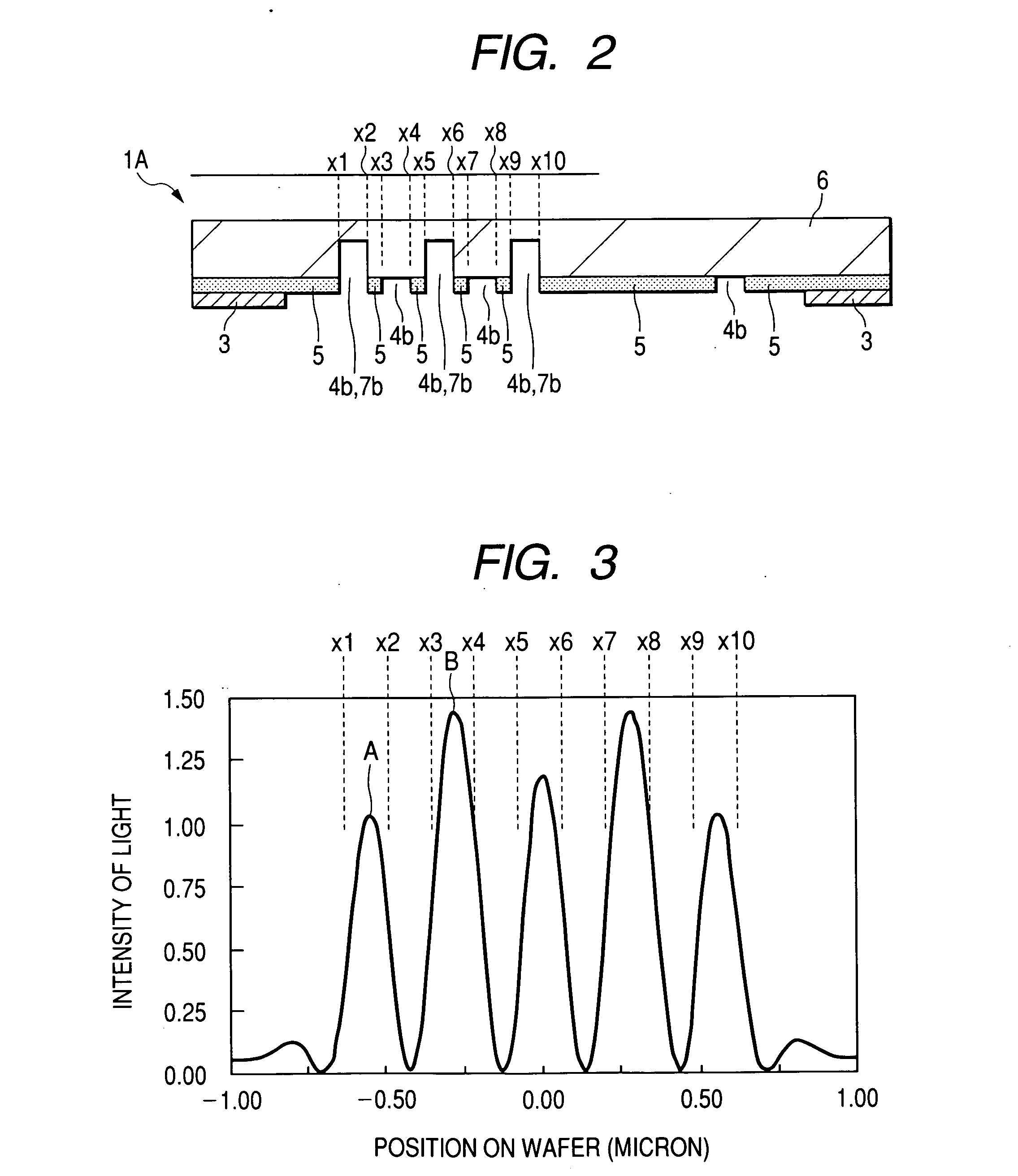Manufacturing method of semiconductor integrated circuit device
a manufacturing method and integrated circuit technology, applied in the direction of instruments, photomechanical equipment, originals for photomechanical treatment, etc., can solve problems such as attenuation of exposure beams, and achieve the effect of reducing pattern data
- Summary
- Abstract
- Description
- Claims
- Application Information
AI Technical Summary
Benefits of technology
Problems solved by technology
Method used
Image
Examples
first embodiment
[0054]FIGS. 1 and 2 show an example of a mask employed for a method of manufacture of a semiconductor integrated circuit device according to a first embodiment of the present invention. FIG. 1 shows an overall top view of the mask 1A of this first embodiment of the present invention. FIG. 2 shows a cross sectional view of the mask 1A as seen along line XA-XA in FIG. 1. The top view of the mask 1A shown in FIG. 1 is hatched specially to make it easier to understand the description. And, coordinates x1 to x10 are given to describe areas of the mask 1A in detail.
[0055] The mask 1A in this first embodiment is used to transfer hole patterns (contact holes or through-holes) as integrated circuit patterns. On a main surface of this mask 1A, there are disposed, for example, two transfer areas 2A and 2B in the vertical direction (the scanning direction SC of an exposure apparatus) as seen in FIG. 1 so as to be limited by a shielding pattern 3. Each of the transfer areas 2A and 2B is equival...
second embodiment
[0084] In this second embodiment, the present invention is applied to a mask for transferring line patterns (gate electrodes or wirings) as integrated circuit patterns. FIG. 21 shows a top view of a mask 1B according to this second embodiment. FIG. 22 shows a cross sectional view of the mask 1B as seen along line XB-XB in FIG. 21. In each transfer area 2A / 2B, there are flat band-like light transmission patterns 4c / 4d used for transferring line patterns. In the massed region of each transfer area 2A / 2B, a plurality of light transmission patterns 4c / 4d are disposed side by side in the horizontal direction as seen in FIG. 21. In the massed region of each transfer area 2A / 23, a phase shifter 7a / 7b is disposed in every second one of the plurality of light transmission patterns 4c / 4d. However, also in this second embodiment, phase shifters 7a and 7b are disposed symmetrically and are inverted in phase in the transfer areas 2A and 2B, just like in the first embodiment. In the sparse region...
third embodiment
[0087] In this third embodiment, a description will be given of a method for forming phase shifters with a film (phase shift film stacking method or stacking phase shifter).
[0088]FIGS. 23 and 24 show cross sectional views of the major portions at each of which the transfer areas 2A and 23 of the mask 1C in this third embodiment are overlaid one upon another for overlay exposure. FIG. 24 shows a cross sectional view of a portion at a line equivalent to the line XA-XA in FIG. 1, while FIG. 23 shows a cross sectional view of a portion to be overlaid upon the other portion shown in FIG. 24. The cross sectional view is for a portion at a line in parallel to the line XA-XA in the transfer area 2A in FIG. 1.
[0089] In the mask 1C in this third embodiment, the phase shifters 7c and 7d are made of, for example, a resist film or a SOG (Spin On Glass) film. The top surface shape of the mask 1C is similar to any of those shown in FIGS. 1 and 21. If phase shifters are made of a film, the thickn...
PUM
| Property | Measurement | Unit |
|---|---|---|
| length | aaaaa | aaaaa |
| length | aaaaa | aaaaa |
| length | aaaaa | aaaaa |
Abstract
Description
Claims
Application Information
 Login to View More
Login to View More - R&D
- Intellectual Property
- Life Sciences
- Materials
- Tech Scout
- Unparalleled Data Quality
- Higher Quality Content
- 60% Fewer Hallucinations
Browse by: Latest US Patents, China's latest patents, Technical Efficacy Thesaurus, Application Domain, Technology Topic, Popular Technical Reports.
© 2025 PatSnap. All rights reserved.Legal|Privacy policy|Modern Slavery Act Transparency Statement|Sitemap|About US| Contact US: help@patsnap.com



